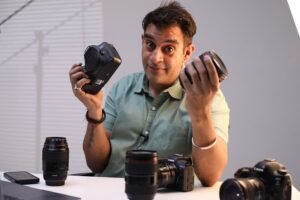Hard Light & Soft Light
Master the play of light in product photography. Learn the art of using hard and soft light to create impactful and visually stunning product shots. From creating dramatic shadows to achieving soft, flattering light, unlock the secrets of lighting.
What's In Store:
- Hard Light Techniques: Create bold contrasts and defined shadows.
- Soft Light Mastery: Achieve a flattering and gentle illumination.
- Lighting Control: Understand techniques to manipulate light for your desired effect.
Mastering Soft And Hard Light In Product Photography
Light is the essence of photography, shaping the mood, texture, and overall feel of an image. Masterclass is welcoming you In the vast world of lighting, discussing its two key players that take centre stage, hard light and soft light. Let’s dive into the intricacies of these light types, exploring their differences, characteristics, and the art of utilizing them in photography.
Let’s start with the basics – understanding how light works. It’s like learning the essential colors before creating a beautiful painting. This journey will guide you through the simple science of lighting, making sure you’re ready to use soft and hard light to give your product photos the perfect vibe. Ready to light up your products? Let’s get started!
1. Understanding The Basics: Hard Light vs. Soft Light
Hard Light
Hard light creates well-defined, sharp shadows and highlights. It is characterized by its concentrated and direct illumination, often resulting in a stark contrast between light and shadow. Think of a bright, direct sun on a clear day – that’s hard light in action.
Soft Light
On the other hand, soft light produces gentle, gradual transitions between shadows and highlights. It is diffused and scattered, reducing the intensity of shadows. Overcast skies or the light from a large, cloudy sky are classic examples of soft light.
2. The Difference In Photography: Capturing Shadows And Highlights3
Hard Light In Photography:
- Dramatic Contrast: Hard light creates bold and dramatic contrasts, emphasizing textures and details.
- Defined Shadows: Shadows under hard light are well-defined, adding depth and dimension to the subject.
- Ideal for Texture: It’s excellent for showcasing textures, making it suitable for certain types of portraits and architectural photography.
Soft Light in Photography:
- Gentle Transitions: Soft light produces smooth transitions between shadows and highlights, reducing the harshness of contrasts.
- Flattering Portraits: Soft light is often preferred for portrait photography, as it tends to be more flattering, minimizing imperfections.
- Even Illumination: It provides even illumination, making it suitable for a wide range of subjects, including product photography.
3. Crafting The Visual Story: Examples And Scenarios
Examples of Hard and Soft Light:
- Hard Light: Capture the rugged details of a weathered building facade or emphasize the texture of tree bark in direct sunlight.
- Soft Light: Create a portrait in the gentle glow of an overcast day or showcase the smooth surface of a product under studio softboxes.
4. The Art Of Photography: Choosing The Right Light For The Scene
Hard Light vs. Soft Light Photography:
- Hard Light Photography: Consider using hard light for scenes that demand a sense of drama, where shadows play a crucial role in defining the subject.
- Soft Light Photography: Opt for soft light when aiming for a more subtle, romantic, or evenly illuminated look, especially in portrait or product photography.
5. Tips For Mastering Light: Bringing Your Vision To Life
- Experimentation: Don’t be afraid to experiment with both hard and soft light in different scenarios to understand their impact.
- Modifiers: Use light modifiers like reflectors, diffusers, or bounce cards to control and manipulate the quality of light.
- Time of Day: Consider the natural light available during different times of the day for outdoor photography.
Congratulations on completing our journey through the world of soft and hard lighting for product photography! Here at FDS Masterclass, we’ve covered everything you need to know in a way that’s easy to understand and put into action.
You’ve learned the basics of how light plays a crucial role in making your products stand out. We explored the differences between soft and hard light, guiding you on when to use each to create the right mood for your photos. It’s not just about taking pictures; it’s about telling a story through your visuals.
In this masterclass, we’ve gone beyond theory, giving you hands-on experience and practical tips that will set you on the path to becoming a pro in product photography. Whether you prefer the gentle touch of soft light or the bold statements made by hard light, you now have the skills to make your products shine.
Your journey doesn’t end here; it’s a beginning. Join us at FDS Masterclass, where we’ve not only provided light for your products but also ignited the spark for your success in product photography. In the dynamic canvas of photography, mastering the interplay between hard and soft light is akin to being an artist with a paintbrush. Each type of light brings its unique characteristics to the visual narrative, allowing photographers to craft stories that evoke emotion and impact.
Whether it’s the bold contrasts of hard light or the gentle transitions of soft light, the magic lies in understanding how to wield these tools to bring your vision to life. So, step into the world of light, experiment, and let your creativity shine!








